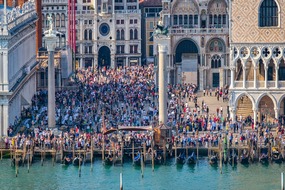THR's opinion
When Mass Tourism Costs: Should Over-Visited Destinations Charge Entry?
 Tourism is simultaneously a vital source of income and a potentially destructive social and environmental force for destinations. Mass tourism has strained any number of tourist destinations, resulting in a never-ending list of issues for full-time residents, their municipalities, and those who govern them.
Tourism is simultaneously a vital source of income and a potentially destructive social and environmental force for destinations. Mass tourism has strained any number of tourist destinations, resulting in a never-ending list of issues for full-time residents, their municipalities, and those who govern them.
Countering the destructive consequences of overtourism is a pressing issue, and destinations have begun implementing a wide range of policies to counteract deleterious effects.
Find below the key takeaways from a recent internal THR Tourism Industry Advisors conversation regarding the effectiveness of different strategies to manage mass tourist numbers.
Case Study: Venice
Earlier this year, Italy put forth a ban on large cruise ships docking in certain parts of the country, placing special emphasis on the Venetian lagoon. Due to the rising threat of removal from the UNESCO World Heritage list, the Venetian government recently declared that it would impose a fee (€3-10) on visitors entering the city. The policy, set to begin enforcement in 2022, would reduce the number of daily visitors that the city receives with the aim of slowing the damaging effects of tourism on the city’s limited infrastructure.
Weighing the Policy’s Strengths and Weaknesses
Benefits
- The funds raised from the entry fee could be applied to maintaining the city and correcting the effect of externalities caused by this type of tourism.
- Most tourist attractions, ranging from monuments and art galleries to natural reserves, already follow a similar model to control the number of visitors they receive. The approach is normalized across destinations and should thus be easy to apply to the city grounds.
Drawbacks
- Tourist destinations tend to face relatively inelastic demand. Attaching a low price tag to entry would be unlikely to change consumption patterns significantly.
- The policy would have the result of effectively converting Venice into a theme park, without addressing the root of the problem.
- The setup of turnstiles, sensors, cameras, etc. at the entry points to the city is unrealistic on an operational or even aesthetic level, as well as conflictual relative to individual privacy and the impact on the city’s full-time residents.
Overall, charging for entry could generate useful revenue for the city, but would be unlikely to deter mass visitation, in addition to presenting inefficient logistical hurdles.
Alternatives with a Longer-Term Horizon
Strategies to mitigate overtourism must be integrated into a destination’s long-term tourism management plans.
Destination marketing can be a powerful tool, for example selectively targeting more ideal visitor segments. Shifting the focus from quantity to quality of tourists can lead to better economic and environmental results, all while reinforcing a more sustainable Venice brand.
Another option to reduce tourist arrivals would be by limiting the tourism product offering. Barcelona, for example, another victim of mass tourism, is gradually moving away from quantities of visitors by imposing stricter supervision on accommodation providers, limiting supply and thus the number of potential arrivals. A similar approach can be seen in Thailand, where transport options leading to fragile island ecosystems are limited, resulting in a natural reduction of travelers.
Key Takeaways
- Both tourism supply and demand sides must reconcile the inherent sustainability issues derived from extractive tourism.
- Tourism-management strategies such as charging for entry to a destination may be successful on some level, but not necessarily for reducing absolute numbers of visitors.
- Governments facing mass tourism issues should refocus their long-term tourism strategies and develop offerings and infrastructure for a more limited number of higher-value visitors.